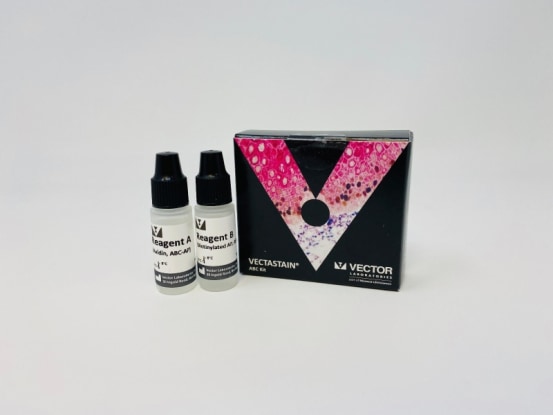VECTASTAIN® ABC-AP Staining Kit (Alkaline Phosphatase, Standard)
Product code : VEC.AK-5000
VEC.AK-5000With more than 50,000 citations to its credit, the VECTASTAIN®ABC kit remains widely popular. Based on the versatile avidin-biotin comple…

You can contact us for more information via the button “quote request'
VECTASTAIN® ABC-AP Staining Kit (Alkaline Phosphatase, Standard)
Product description
With more than 50,000 citations to its credit, the VECTASTAIN® ABC kit remains widely popular. Based on the versatile avidin-biotin complex interaction, the system is modular, and along with our selection of secondary antibodies, can accommodate a wide array of primary antibody and tissue species. Our ABC kits are economical and continue to be a staple product in any immunohistochemistry (IHC) and immunocytochemistry (ICC) laboratory.
The sensitivity of the VECTASTAIN® ABC-AP system is comparable to that of the peroxidase VECTASTAIN® Elite® ABC system. The VECTASTAIN® ABC-AP Kits may be preferred for tissues that have high endogenous peroxidase activity. The system also offers additional substrate color choices.
VECTASTAIN® ABC-AP Kit Components:
- 2 ml Reagent A
- 2 ml Reagent B
Reagent A and B when mixed form the ABC-AP complex.
Kit is sufficient to stain approximately 1000-2000 sections or fifty 100 cm2 blots.
The Avidin Biotin Complex Method
The VECTASTAIN® ABC systems are extremely sensitive due to the form and number of active enzyme molecules associated with the preformed Avidin/Biotinylated enzyme Complex. This ABC complex takes advantage of two important properties of avidin: 1) an extraordinarily high affinity for biotin (over one million times higher than antibody for most antigens), and 2) four biotin-binding sites. These properties allow macromolecular complexes (ABCs) to be formed by mixing Avidin DH (Reagent A) with its paired biotinylated enzyme (Reagent B) prior to use. The ABC reagent, once formed, remains stable for many hours after formation and can be used for several days after preparation.
The VECTASTAIN® ABC Reagent can be used to detect any molecule that is biotinylated. This property gives the avidin-biotin complex (ABC) method great versatility in the types of targets that can be detected as well as the types of applications in which it can be employed. Biotinylated primary antibodies, secondaries, lectins, neuronal tracers, nucleic acids, and ligands can be effectively visualized in applications such as:
- Tissue staining
- Multiple labeling (Multiplex IHC)
- Western blotting
- Southern and northern blotting
- In situ hybridization detection (ISH)
- Enzyme immunoassays (ELISA)
- Neuronal tracing
All applications benefit from the high sensitivity, low background, reproducibility, and economy of the VECTASTAIN® ABC system.
Choosing a VECTASTAIN® ABC Kit
1) Choose an enzyme system:
The VECTASTAIN® ABC Kits are available with a choice of three different enzyme systems
- Peroxidase (ABC, Elite® ABC, RTU or Kits)
- Alkaline Phosphatase (ABC-AP)
- Glucose Oxidase (ABC-GO)
2) Choose the biotinylated secondary antibody:
To detect a biotinylated target, you will need only the ABC Reagent contained in the Standard Kit, followed by an appropriate substrate.
To detect an unlabeled primary antibody, you will need a biotinylated secondary antibody that binds to the primary antibody species chosen, the ABC Reagent, and an appropriate substrate. For example, to detect a primary antibody made in rabbit, the appropriate choice is a VECTASTAIN® ABC Kit designated “Rabbit IgG”.
For additional versatility and convenience, Vector Laboratories offers secondary antibody products that recognize more than one species of primary antibody. Our Universal Biotinylated Anti-Mouse/Rabbit IgG secondary antibody (Cat. No. BA-1400) is a cocktail of biotinylated anti-mouse IgG and anti-rabbit IgG, designed for use with both rabbit and mouse primary antibodies. This antibody should not be used to stain tissues from rodents or rabbits due to its reactivity with IgG present in the tissues of these species. The Universal Pan-Specific Anti- Mouse/Rabbit/Goat secondary antibody (Cat. No. BA-1300) (which is included in our VECTASTAIN® Universal Kits) is a cocktail of biotinylated anti-mouse IgG, anti-rabbit IgG, and anti-goat IgG that recognizes mouse, rabbit, and goat primary antibodies. This secondary antibody should not be used to stain rat, mouse, or other rodent, rabbit, goat, bovine, or sheep tissue due to potential reactivity with endogenous IgG.
3) Choose a convenient format:
Finally, several kits are available in prediluted, stabilized formats for convenience and ease of use. See kits designated R.T.U. or Ready-To-Use.
Consider Species Cross-Reactivity
When choosing the optimal detection system for your application, it is important to consider not only the species of the primary antibody but also the species of the tissue under examination. If the species of the primary antibody and the species of the tissue are closely related (e.g. rat and mouse), the biotinylated secondary antibody may cross react with endogenous IgG in the tissue section leading to background staining. The following three options minimize background staining in these instances:
- Biotinylate the primary antibody (ProtOn™ Biotin Labeling Kit, Cat. No. PLK-1202) and detect with a Standard VECTASTAIN® Elite® ABC Kit, PK-6100, (only includes the avidin-biotin complex, or ABC reagent).
- Use a biotinylated secondary antibody specifically adsorbed to remove cross-reacting antibodies of closely-related species (e.g. biotinylated anti-mouse IgG, rat adsorbed, Cat. No. BA-2001).
- Use the M.O.M.™ Immunodetection System for applications of mouse primary antibodies on mouse tissue.
Substrates
After choosing the VECTASTAIN® ABC Kit for your application, select a substrate that matches the enzyme system of the kit.
VECTASTAIN® ABC-AP Staining Kit (Alkaline Phosphatase, Standard)
Product specifications
Packaging Unit
1 kit
Brand
Vector Laboratories
Category
VectaStain ABC-AP kits (alkaline phosphatase)
VECTASTAIN® ABC-AP Staining Kit (Alkaline Phosphatase, Standard)
Product documents

